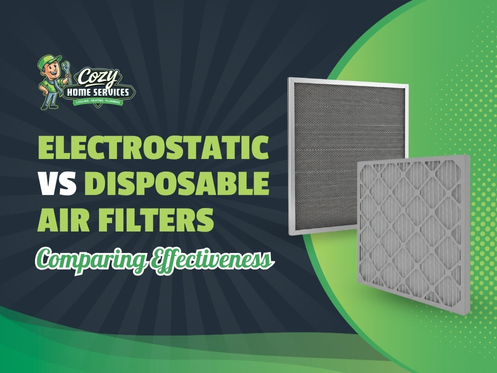Quick Summary
- Electrostatic air filters use static electricity to trap particles. They can be washed and reused.
- Disposable HEPA and pleated filters generally capture smaller particles more effectively than electrostatic options, making them better for allergy sufferers.
- Electrostatic filters cost more upfront but can save money over time, whereas disposable filters require ongoing purchases but offer greater convenience.
- The best air filter for your home’s HVAC depends on your budget, air quality concerns, and maintenance preferences.
Are you having a hard time choosing between electrostatic and disposable air filters? You’re not alone. The HVAC system in your home relies on proper filtration to keep your family comfortable and your indoor air quality at healthy levels. The filter you choose affects how well your system runs and how much dust settles on your furniture. Read on to learn how to decide on the best air filter for your home’s HVAC.
Why Air Filter Choice Matters for Home Comfort
The air filter in your HVAC acts as your first line of defense against airborne particles that can negatively impact your family’s health and comfort. A quality filter reduces allergens, prevents system breakdowns, and keeps your heating and cooling system running efficiently. The right air filter can address common causes of indoor air pollution, like pet dander and cooking fumes.
Filter effectiveness is most commonly measured using the MERV scale (Minimum Efficiency Reporting Value). Ratings range from 1 to 20, with higher numbers indicating finer particle capture. Higher MERV filters improve air quality but also reduce system airflow. This can increase fan energy use by as much as 15% if the system isn’t properly sized.
What Are Electrostatic Air Filters?
Electrostatic air filters generate a static charge as air passes through multiple layers of material. This charge attracts and holds particles like a magnet, trapping dust, pollen, and other contaminants. These differ from powered electronic air cleaners, which actively charge particles using electricity.
When air flows through multiple layers of polypropylene or other synthetic materials, friction between them creates an electrostatic charge that attracts particles. Most electrostatic air filters can be removed, rinsed with water, and reinstalled once dry. You’ll spend more initially, but you won’t need to buy replacements for years.
In evaluating an electrostatic air filter’s effectiveness, most typically carry a MERV rating between 4 and 10 or offer equivalent performance in that range. They can handle larger particles like dust, but struggle with smaller contaminants like bacteria and fine allergens. If you’re looking to prevent indoor air pollution from microscopic particles, a higher-rated disposable filter may be more suitable.
What Are Disposable Air Filters?
Disposable filters are single-use products designed to be thrown away and replaced after accumulating dirt. Fiberglass is the most basic of disposable HVAC air filter types. They cost just a few dollars and typically offer a modest MERV rating of 1 to 5. They primarily protect your equipment rather than improving air quality.
Pleated filters offer better performance with MERV ratings between 8 and 13, using accordion-folded material to increase surface area. HEPA filters are generally equivalent to a MERV 17 or higher: they’re tested to remove 99.97% of particles at approximately 0.3 microns under standardized test conditions.
As you conduct your disposable air filter comparison shopping, note that many HVAC manufacturers specify a maximum MERV rating for their systems. Exceeding this limit without modifications can void warranties or cause motor damage. In Northern California, where wildfire smoke can significantly affect indoor air, the California Air Resources Board recommends using filters rated MERV 13 or higher during smoke events if your HVAC system supports it.
Which Air Filter Is More Effective?
High-quality disposable pleated or HEPA filters outperform electrostatic options for capturing the smallest particles. Their denser material and higher MERV ratings mean better filtration of the tiny contaminants that trigger allergies and respiratory issues.
Electrostatic filters excel at trapping larger particles and offer environmental benefits since they’re not thrown away monthly. They work reasonably well for general dust control in homes without severe indoor air quality concerns.
Deciding on the best air filter for your home’s HVAC involves trade-offs. Higher MERV ratings are recommended for families with severe allergies. By comparison, homeowners prioritizing sustainability and long-term savings may prefer electrostatic options instead. Older HVAC equipment may not have the fan power to pull air through denser filters, either.
Cost & Maintenance Considerations
A basic disposable fiberglass filter costs as little as $2 to $5, while quality pleated filters run $15 to $30 each. With up to 12 replacements annually, you’re spending as much as $360 per year. Over five years, that can add up to $300 to $1,800 just on filters.
Electrostatic filters cost about $50 to $100 upfront, but they should last five to 10 years with proper care. In typical use cases, the break-even point can occur within the first two years, assuming regular replacement costs of disposables and comparable maintenance costs.
As part of our comprehensive HVAC services, our certified technicians will assess your current system and recommend the right filter type for your specific needs and equipment. Take advantage of our current specials for more cost-saving opportunities.
Service Areas We Cover
Cozy Home Services is proudly serving homeowners throughout Northern California with expert HVAC maintenance and indoor air quality solutions.
- 95688 – Vacaville
- 94533 – Fairfield
- 94590 – Vallejo
- 95620 – Dixon
- 94591 – Benicia
- … and more!
Schedule HVAC Maintenance with Cozy Home Services Today
Your air filter is just one component of a healthy, efficient HVAC system. Regular professional maintenance keeps everything running smoothly and helps you make informed decisions about upgrades, such as better filtration. Check out our customer reviews to hear how improved filtration has helped local families breathe easier.
Contact us today at (707) 702-6373 to schedule your appointment, or fill out our online form for a free estimate.
Frequently Asked Questions
Which is better for my HVAC system: washable or disposable filters?
Washable electrostatic filters work well in systems that can’t handle high airflow resistance and for homeowners seeking long-term cost savings. Disposable filters offer better performance for allergy sufferers and require less maintenance effort. Always check your HVAC manufacturer’s recommendations for maximum MERV ratings before upgrading.
Do electrostatic air filters really improve indoor air quality?
Electrostatic filters effectively reduce visible dust, pet hair, and larger particles. However, they’re less effective than high-MERV disposable filters at capturing the microscopic particles that trigger allergies and respiratory issues. For homes without severe air quality concerns, they provide meaningful improvement over basic fiberglass filters.
How often should I clean a washable electrostatic filter?
Most manufacturers recommend cleaning a washable electrostatic filter every one to three months under normal conditions. Increase frequency if you have multiple pets, live in a dusty area, or run your HVAC system constantly. It’s a good idea to wash it after a wildfire event, too. Always allow the filter to dry completely before reinstalling to prevent mold growth.


